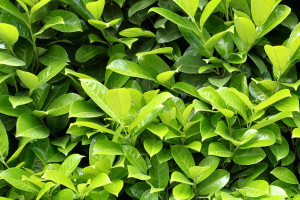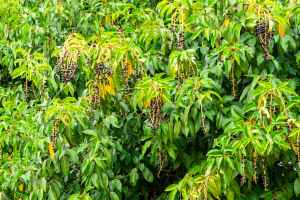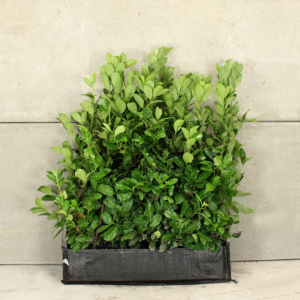Our Ultimate Laurel Hedging Guide
The Laurel family is extremely popular. It consists of various Laurel shrubs, hedging plants and some topiary. If you're looking for a garden plant that is practical and aesthetically pleasing on the eye, Laurel hedging ticks off all the boxes. It's a highly popular shrub that is seen in thousands of gardens throughout the UK. Hedges Direct supplies the best selection of Laurel hedging plants, from compact low-hedging to ready-grown screening we have the perfect variety to suit every gardening need.
The types of Laurel plants we offer are evergreen, providing year-round cover and interest. Each Laurel species has a unique set of characteristics that can be utilised to help you achieve a range of gardening goals. With an abundance of practical advantages, added interest and ability to grow in challenging environments, Laurel hedging should undoubtedly be a significant contender when considering garden landscape ideas.
Laurel Hedging Species
Cherry and Portuguese Laurel are the most popular type of hedging from this species family.
Cherry Laurel hedging is a real favourite, hence the alternate name, the Common Laurel. Cherry Laurel is a large hedge plant and primarily used for its large thick and glossy green leaves. As a result, it acts as an effective privacy screen that reduces wind and noise passing through its dense structure. This hedging plant is available to purchase from 30cm to 3.5m in height, providing you with a fantastic choice of sizes and prices to suit your needs and budget. Cherry Laurel can also have a considerable impact on the first day they are planted.
The Portuguese Laurel hedge plant boasts rich, darker green leaves along its striking deep red-pink stems. The leaves are more pointed than the rounder type found on Cherry Laurel hedging and have a flowing, elegant habit. Portuguese Laurel hedge plant is classic, evergreen hedging that develops small sprays of white fragrant flowers in spring with small red-purple berries later in the year. This particular species of Laurel hedging is available in a variety of heights and maturity to suit any garden.
Instant Laurel Hedging (Ready Grown Metre Long Troughs)
For instant hedging, both Cherry Laurel and Portuguese Laurel aslo come in ready-grown units for a seamless hedge. With beautifully developed, bushy mature foliage and a robust and well-established root structure, these instant Laurel hedging troughs once planted, will create a healthy, complete hedge for impressive impact.
Laurel hedge heights are available from 1m up to 1.75m for the ultimate impact. Although Laurel is more costly than other hedge plants, they will provide you with a fully developed hedge in the quickest possible time. More information about instant hedging can be found here.
Colourful Laurel Hedges
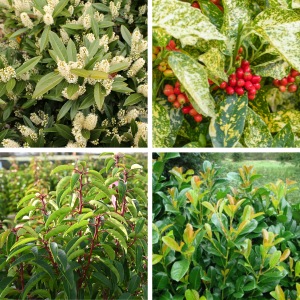

As well as their practicality, Laurel trees and hedges are used in some wonderful garden designs for their aesthetic appearance. They are used as low hedges to create emphasis and structure by bordering larger plants, pathways and other garden features and for their remarkable colours. For low growing Laurel hedging, consider Compact Laurel or Spotted Laurel.
Compact Laurel also referred to as Prunus laurocerasus ‘Otto Luyken’, is a small, sturdy plant with dark green leaves that have a lightly shaded underneath. It boasts white flowers in spring before displaying shiny, black and red berries in autumn.
Spotted Laurel, also known as Aucuba japonica ‘Crotonifolia’ or Japanese Laurel, is famous for its variegated foliage, polished green leaves with gold and yellow splashes.Small red berries also complement its distinctive foliage in summer.
Portuguese Laurel is noted for its dark glossy green leaves and dark red stems. Laurel Etna has bright green rounded glossy leaves that on initial growth have a beautiful warm bronzed appearance before turning green as they age. Laurel Etna also features soft white flowers in spring and glossy black berries in autumn. An array of British birds and other small animals adore the luscious berries that laurel hedging plants produce, bringing added wildlife value to a garden.
Bay Laurel: Fragrant and Edible Laurel Hedging
Bay Laurel is the only member of the Laurel family that is both edible and fragrant. Famous for its culinary leaves used dried or fresh to season many a dish, Bay Laurel also known as Sweet Bay, is a favourite for several reasons. As a hedge, Bay Laurel has a beautiful deep green foliage, lighter at the tips where the new growth is developing and boasts sprays of pale yellow-green flowers in spring. Its fragrant leaves bring a touch of the Mediterranean to any home or garden and its origin also means it has a natural drought tolerance in warmer weather conditions.
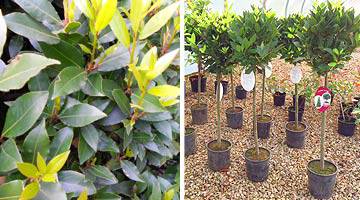

This lovely evergreen however, is also the perfect shrub with which to create Topiary Standards, producing plants with a long clear stem on which a ball of foliage sits proudly at the head. These delightful Laurel trees often grace gardens, walkways, entrances and even homes with their classic topiary styling.
Planting a Laurel Hedge and Growing Conditions
Difficult growing sites determine whether certain types of plants will be able to establish. We all want to look outside and see our plants thriving in stable, healthy conditions and not succumb to environmental damage. There are little restrictions as to growing requirements for planting Laurel hedging, as their hardiness is the primary factor in their popularity. All of the Laurel species we supply have the ability to develop in poor soil conditions. Compact Laurel, Laurel Etna and Cherry Laurel thrive in well-drained, dry sites, whereas Spotted Laurel & Laurel 'Caucasica' grow particularly well in moist and wet soils. All our Laurel hedging will develop adequately in either dry or damp conditions. For those planting Laurel hedging in covered or shaded areas, the Laurel species we offer flourish in full shade, except Bay Laurel which can withstand partial shade.
Choosing a Laurel hedge can be overwhelming at times, so we’ve collated this useful chart to try and make selecting the right plant easier. Remember all of these Laurels are evergreen.
| Variety | Ideal hedge height | Growth rate | Dry sites | Damp sites | Exposed | Shade | Coastal | Poisonous |
|---|---|---|---|---|---|---|---|---|
| Cherry Laurel | 1.5 - 5m | Fast | Yes | Yes | Yes | Full | No | Yes |
| Portuguese Laurel | 1.5 - 5m | Medium | Yes | Yes | Yes | Full | No | Yes |
| Bay Laurel | 1 - 2m | Slow | Yes | Yes | Yes | Partial | Yes | No |
| Laurel Etna | 1.5 - 5m | Fast | Yes | Yes | Yes | Full | No | Yes |
| Compact Laurel | 0.8 - 1.2m | Slow | Yes | Yes | No | Full | Yes | Yes |
| Laurel Caucasica | 1.5 - 5m | Fast | Yes | Yes | Yes | Full | No | Yes |
| Spotted Laurel | 1.5 - 4m | Slow | Yes | Yes | No | Full | Yes | Yes |
Laurel Hedge Plant Problems
There are no severe Laurel hedging problems associated with any of the species we supply. There are some minor issues which can cause leaves to look unsightly with brown patches in places, ragged leaves and the development of holes in the foliage.
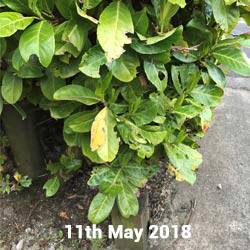

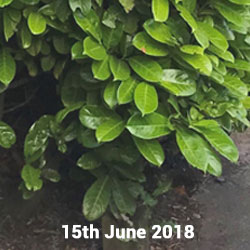

Powdery Mildew and Leaf Spot Fungi can be an annoyance creating browning, leaf distortion and some holes when conditions are suitable for growth. These damp conditions can also encourage Bacterial Shothole where brown lesions with a yellow circumference eventually give way to the dead material falling out, creating the 'shot-hole' appearance.
Treatment of Powdery Mildew and Leaf Spot Fungi conditions can be achieved with many fungicides readily available from garden centres. But even without treatment, plants will often grow through the issue with new leaves unaffected by the problem, which generally looks more serious than it actually is.
Is Laurel Hedging Poisonous?
We're no strangers to being asked if certain Laurel hedging and trees are poisonous to household pets or humans (particularly small children). ALL parts (leaves, berries etc.) of all Laurels, are poisonous to livestock and animals. We have had no reports of children or pets being directly affected by the foliage of these hedging plants; in our experience they hold no real attraction, however it is best to avoid planting if animals of any kind are likely to come into contact. If you are concerned about your children we’d recommend choosing Bay Laurel or looking at alternative hedge plants.
Frequently asked questions
The best time to plant a Laurel hedge is from autumn through to early spring when the soil is moist and temperatures are mild. This allows the plants to establish their root systems before facing more severe weather conditions in winter. Try not to plant during hot summer months when the risk of stress and dehydration is higher.
Space the individual Laurel plants approximately 60 to 90 centimetres (2-3 feet) apart. This gives them plenty of room to grow and fill in the gaps, creating a dense and visually appealing hedge over time. Small bare root plants will need a higher planting density than larger potted or root balls plants.
It’s worth noting that you may want to adjust the spacing for different Laurel hedge types with various growth and density rates.
Prune Laurel plants in late winter or early spring before new growth emerges. Giving them a trim at this time of year causes minimal stress to the plant and encourages vigorous regrowth. Try not to prune in late summer or autumn, as it can make it difficult for Laurel to harden off for winter.
Take care around early spring as we may get some late frosts that could damage any new, delicate growth that was encouraged due to the pruning.
To lend a helping hand and encourage Laurel to grow faster, plant them in well-draining soil with plenty of organic matter. Water them regularly, especially during dry spells, and apply a balanced fertiliser in early spring. As we previously mentioned, pruning Laurel in late winter or early spring can also stimulate growth by removing any dead or weak branches.
Just like if you want your Laurel hedge to grow faster, regular pruning should help to encourage lateral branching, causing it to thicken. Give the sides a trim and remove a few inches of new growth to promote denser foliage. You should also keep Laurel well-fed, watered and in a sunny spot to help it flourish – patience is key! It may take a few seasons for your Laurel hedge to thicken but keep giving it plenty of TLC and you should see a noticeable difference.
If your Laurel hedge isn’t quite growing as you hoped, review its growing conditions to spot if there are any noticeable issues you can fix. Make sure it has proper drainage, isn’t overwatered, and has access to lots of sunlight. Take a close look at its foliage and prune away any dead, diseased, or dying branches so it can focus all its energy on healthy areas instead. You may also want to apply a fertiliser to give it a boost.
If you’ve spotted yellow leaves on your Laurel hedge, it could be because of many different reasons. Low nitrogen levels, too much lime or chalk in the soil, under or overwatering, and too much direct sunlight can all cause Laurel leaves to turn yellow.
A fertiliser will help balance soil nutrients and checking the soil can help you understand its moisture levels – it should feel moist, not soggy. If the roots are waterlogged, loosen the soil and aerate it with a pitchfork, being careful not to disrupt the roots.
Black leaves on a Laurel plant can be a sign of fungal diseases, like leaf spot fungus, or bacterial infections, such as bacterial shothole disease. Taking quick action is the best way to limit their spread, so cut back any affected branches and safely dispose of the cuttings.
Proper air circulation around the plant and making sure to avoid overwatering will help to reduce the chances of moisture-related diseases.
 Hedges Direct
Hedges Direct 




